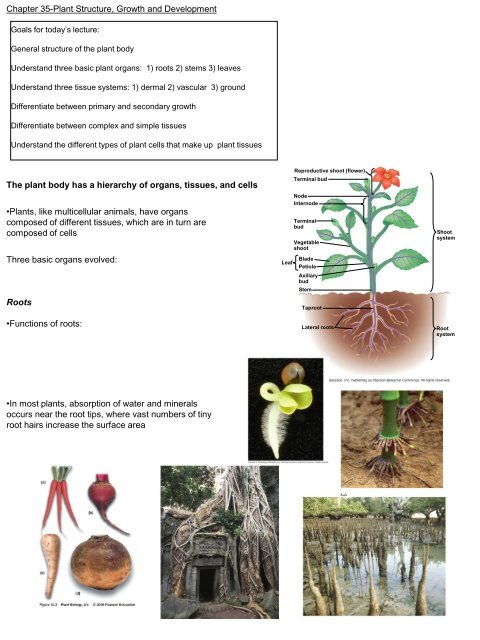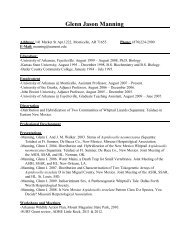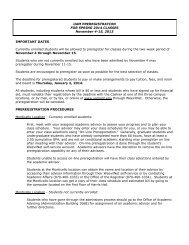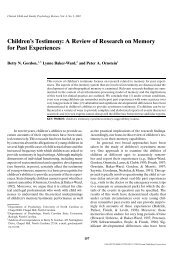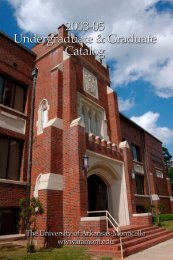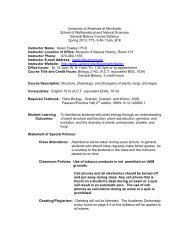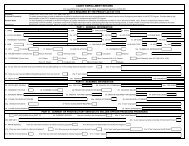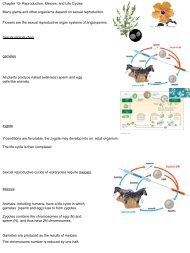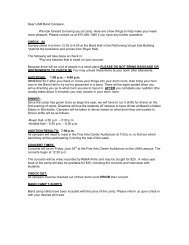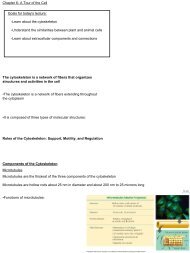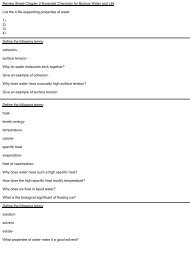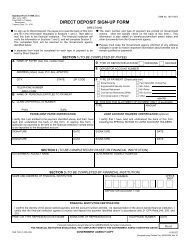The plant body has a hierarchy of organs, tissues, and cells •Plants ...
The plant body has a hierarchy of organs, tissues, and cells •Plants ...
The plant body has a hierarchy of organs, tissues, and cells •Plants ...
Create successful ePaper yourself
Turn your PDF publications into a flip-book with our unique Google optimized e-Paper software.
Chapter 35-Plant Structure, Growth <strong>and</strong> Development<br />
Goals for today’s lecture:<br />
General structure <strong>of</strong> the <strong>plant</strong> <strong>body</strong><br />
Underst<strong>and</strong> three basic <strong>plant</strong> <strong>organs</strong>: 1) roots 2) stems 3) leaves<br />
Underst<strong>and</strong> three tissue systems: 1) dermal 2) vascular 3) ground<br />
Differentiate between primary <strong>and</strong> secondary growth<br />
Differentiate between complex <strong>and</strong> simple <strong>tissues</strong><br />
Underst<strong>and</strong> the different types <strong>of</strong> <strong>plant</strong> <strong>cells</strong> that make up <strong>plant</strong> <strong>tissues</strong><br />
<strong>The</strong> <strong>plant</strong> <strong>body</strong> <strong>has</strong> a <strong>hierarchy</strong> <strong>of</strong> <strong>organs</strong>, <strong>tissues</strong>, <strong>and</strong> <strong>cells</strong><br />
•Plants, like multicellular animals, have <strong>organs</strong><br />
composed <strong>of</strong> different <strong>tissues</strong>, which are in turn are<br />
composed <strong>of</strong> <strong>cells</strong><br />
Three basic <strong>organs</strong> evolved:<br />
Roots<br />
•Functions <strong>of</strong> roots:<br />
Leaf<br />
Reproductive shoot (flower)<br />
Terminal bud<br />
Node<br />
Internode<br />
Terminal<br />
bud<br />
Vegetable<br />
shoot<br />
Blade<br />
Petiole<br />
Axillary<br />
bud<br />
Stem<br />
Taproot<br />
Lateral roots<br />
Shoot<br />
system<br />
Root<br />
system<br />
•In most <strong>plant</strong>s, absorption <strong>of</strong> water <strong>and</strong> minerals<br />
occurs near the root tips, where vast numbers <strong>of</strong> tiny<br />
root hairs increase the surface area
Stems<br />
•A stem is an organ consisting <strong>of</strong><br />
Nodes – the region <strong>of</strong> the stem from<br />
which 1 or more leaves or<br />
branches emerge<br />
Internode – the stem regions between<br />
the nodes<br />
•Many <strong>plant</strong>s have modified stems<br />
Leaves<br />
•<strong>The</strong> leaf is the main photosynthetic organ <strong>of</strong><br />
most vascular <strong>plant</strong>s<br />
•Leaves generally consist <strong>of</strong><br />
•Monocots <strong>and</strong> eudicots differ in the arrangement <strong>of</strong><br />
veins, the vascular tissue <strong>of</strong> leaves
•Some <strong>plant</strong> species have evolved modified leaves that serve various functions<br />
Plant bodies are composed <strong>of</strong> <strong>organs</strong>, <strong>tissues</strong>, <strong>and</strong> <strong>cells</strong><br />
Growth<br />
All <strong>plant</strong>s have growth points for shoot <strong>and</strong> root<br />
tips called apical meristems.<br />
•Apical meristems elongate shoots <strong>and</strong> roots, a process called primary growth<br />
Shoot apical meristems<br />
Root apical meristems
Apical meristems <strong>of</strong> most <strong>plant</strong>s generate 3 types <strong>of</strong> tissue systems:<br />
<strong>The</strong>se tissue systems develop from precursor <strong>tissues</strong>:<br />
protoderm<br />
Dermal<br />
tissue<br />
Ground<br />
tissue<br />
Vascular<br />
tissue<br />
In nonwoody <strong>plant</strong>s, the dermal tissue system consists <strong>of</strong> the epidermis<br />
In woody <strong>plant</strong>s, protective <strong>tissues</strong> called periderm replace the<br />
epidermis in older regions <strong>of</strong> stems <strong>and</strong> roots<br />
procambium<br />
<strong>The</strong> vascular tissue system carries out long-distance transport <strong>of</strong><br />
materials between roots <strong>and</strong> shoots<br />
<strong>The</strong> two vascular <strong>tissues</strong> are xylem <strong>and</strong> phloem<br />
xylem<br />
phloem<br />
ground meristem<br />
Secondary meristems produce wood <strong>and</strong> bark<br />
Trees, shrubs, <strong>and</strong> woody vines have 2 additional meristems:
Shoot apical<br />
meristems<br />
(in buds)<br />
Primary growth in stems<br />
Epidermis<br />
Cortex<br />
Primary phloem<br />
Vascular<br />
cambium<br />
Cork<br />
cambium<br />
Lateral<br />
meristems<br />
Pith<br />
Pith<br />
Secondary growth in stems<br />
Primary xylem<br />
Periderm<br />
Cork<br />
cambium<br />
Primary<br />
xylem<br />
Cortex<br />
Primary<br />
phloem<br />
Root apical<br />
meristems<br />
Secondary<br />
xylem<br />
Secondary<br />
phloem<br />
Vascular cambium<br />
Secondary growth<br />
<strong>The</strong> vascular cambium produces lignin-rich secondary xylem tissue to the inside (wood) <strong>and</strong> secondary phloem to the<br />
outside (inner bark).<br />
•As a tree or woody shrub ages, the older layers <strong>of</strong><br />
secondary xylem, the heartwood, no longer<br />
transport water <strong>and</strong> minerals<br />
•<strong>The</strong> outer layers, known as sapwood, still<br />
transport materials through the xylem<br />
Secondary<br />
xylem<br />
Secondary phloem<br />
Vascular cambium<br />
Late wood<br />
Early wood<br />
Cork<br />
cambium<br />
Cork<br />
Periderm<br />
Xylem ray<br />
Bark<br />
Transverse section<br />
<strong>of</strong> a three-yearold<br />
Tilia (linden)<br />
stem (LM)<br />
0.5 mm<br />
0.5 mm
Plant <strong>tissues</strong> may be described in two types:<br />
Simple <strong>tissues</strong><br />
<strong>The</strong> normal metabolic <strong>cells</strong> <strong>of</strong> the <strong>plant</strong>, performing<br />
such tasks as photosynthesis, respiration, <strong>and</strong><br />
storage.<br />
2) Complex <strong>tissues</strong>,<br />
<strong>The</strong>se <strong>tissues</strong> make up the <strong>plant</strong>’s vascular system <strong>and</strong> outer coating.<br />
<strong>The</strong>re are three types <strong>of</strong> simple <strong>tissues</strong>:<br />
1)Parenchyma tissue<br />
Pith from impatiens stem.<br />
Pine leaf <strong>cells</strong>.<br />
Parenchyma <strong>cells</strong> have many different shapes.<br />
2) Collenchyma tissue<br />
3) Sclerenchyma tissue<br />
Collenchyma <strong>cells</strong> are commonly<br />
found in bundles in the young shoot or<br />
in leaves.<br />
-due to very thick, lignified secondary cell walls.<br />
<strong>The</strong>re are two types <strong>of</strong> <strong>cells</strong> found in sclerenchyma, fibers <strong>and</strong> sclereids.<br />
This image shows a bundle <strong>of</strong><br />
sclerenchyma fibers in cross<br />
section.<br />
Fibers<br />
-elongate <strong>cells</strong> with tapered ends<br />
sclereids<br />
-angular <strong>cells</strong> that may occur in aggregates or<br />
singly.
Complex <strong>tissues</strong> are those <strong>tissues</strong> that are made up <strong>of</strong> multiple cell types.<br />
Complex <strong>tissues</strong> make up the specialized <strong>tissues</strong> <strong>of</strong> vascular <strong>plant</strong>s.<br />
<strong>The</strong> vascular system includes the most distinctive <strong>of</strong> the<br />
complex <strong>tissues</strong>.<br />
<strong>The</strong> two major types <strong>of</strong> <strong>tissues</strong> in the vascular system are<br />
xylem <strong>and</strong> phloem.<br />
SUGAR-CONDUCTING CELLS OF THE PHLOEM<br />
WATER-CONDUCTING CELLS OF THE XYLEM<br />
Sieve-tube members:<br />
longitudinal view<br />
(LM)<br />
Vessel Tracheids<br />
100 µm<br />
Companion<br />
cell<br />
Sieve-tube<br />
member<br />
Plasmodesma<br />
Sieve-tube members:<br />
longitudinal view<br />
Sieve<br />
plate<br />
Nucleus<br />
Cytoplasm<br />
Companion<br />
cell<br />
Sieve plate with pores (LM)<br />
30 µm<br />
15 µm<br />
Tracheids <strong>and</strong> vessels<br />
(colorized SEM)<br />
Vessel elements with<br />
perforated end walls<br />
Vessel<br />
element<br />
Pits<br />
Tracheids<br />
SUGAR-CONDUCTING CELLS OF THE PHLOEM
Study outline-Chapter 35-Plant Structure, Growth <strong>and</strong> Development<br />
Reproductive shoot (flower)<br />
Terminal bud<br />
Know general terminology <strong>of</strong> the <strong>plant</strong> <strong>body</strong> (See Fig.)<br />
Underst<strong>and</strong> structure <strong>and</strong> function <strong>of</strong> the three basic <strong>organs</strong> in the <strong>plant</strong>..<br />
1) roots 2) stem 3) leaves<br />
(Study figures <strong>and</strong> images from book <strong>and</strong> know terminology).<br />
Underst<strong>and</strong> structure <strong>and</strong> function <strong>of</strong> the three tissue systems in <strong>plant</strong>s.<br />
1) dermal 2) vascular 3) ground tissue<br />
(Study figures <strong>and</strong> images from book <strong>and</strong> know terminology)<br />
Node<br />
Internode<br />
Terminal<br />
bud<br />
Vegetable<br />
shoot<br />
Blade<br />
Leaf<br />
Petiole<br />
Axillary<br />
bud<br />
Stem<br />
Taproot<br />
Lateral roots<br />
Shoot<br />
system<br />
Root<br />
system<br />
Underst<strong>and</strong> the function <strong>of</strong> an apical meristem.<br />
Underst<strong>and</strong> the difference between primary growth <strong>and</strong> secondary growth in <strong>plant</strong>s.<br />
Be able to differentiate between tissue systems, <strong>tissues</strong> (simple <strong>and</strong> complex), <strong>and</strong> different types <strong>of</strong> <strong>cells</strong>.<br />
protoderm, procambium, <strong>and</strong> ground meristem<br />
Simple <strong>tissues</strong>-parenchyma, collenchyma, <strong>and</strong> sclerenchyma- What type <strong>of</strong> <strong>cells</strong> are they composed <strong>of</strong>?<br />
What is the function <strong>of</strong> each?<br />
Complex <strong>tissues</strong>-xylem <strong>and</strong> phloerm-What type <strong>of</strong> <strong>cells</strong> are they composed <strong>of</strong>?<br />
What is the function <strong>of</strong> each?<br />
precursor <strong>tissues</strong> that give rise to epidermis, vascular tissue, <strong>and</strong><br />
ground tissue


